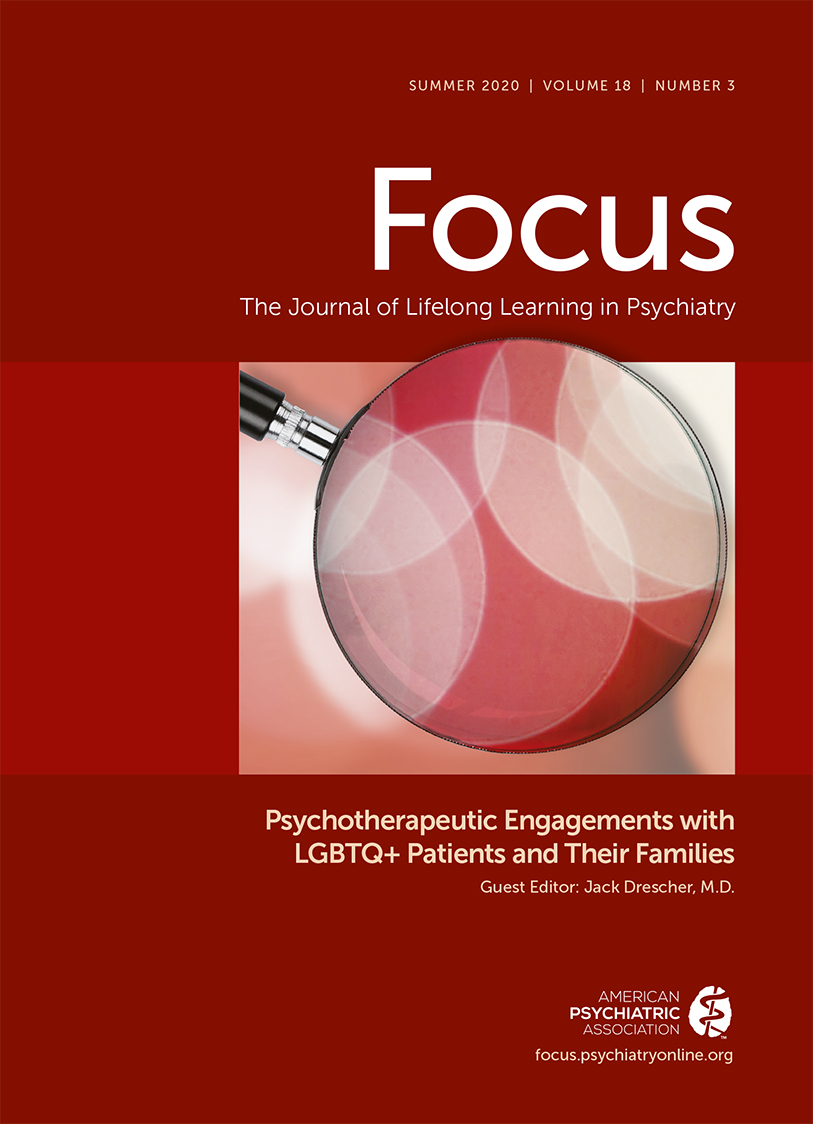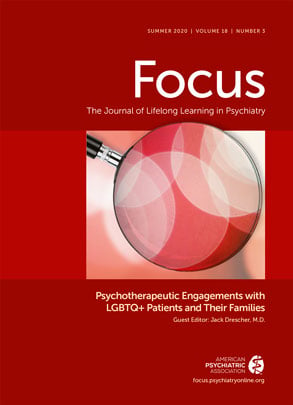The following fictionalized case has been written on the basis of the authors’ cumulative experience to illustrate considerations for care of LGBTQ patients in acute psychiatric settings.
Aiden is a 22-year-old who identifies as queer. He first came out to himself as a lesbian when he was 13 and then as transgender at 17. He began to transition his gender presentation and to use male pronouns during his senior year of high school. His family was hostile throughout his coming out process, and when he began to transition, they threw him out of the house. He spent 2 years homeless and living intermittently on the street, where he was physically assaulted several times and sexually assaulted once. Starting at age 14, he had numerous suicide attempts, including an acetaminophen overdose that resulted in admission to an intensive care unit. At age 20, he attempted to jump off an overpass onto a highway but was stopped and wrestled to the ground by a passing bicyclist. He had numerous admissions to several different psychiatric hospitals, however, he never attended any follow-up appointments. He smokes tobacco and marijuana daily and recently started using synthetic cannabinoids. He was most recently brought to the emergency department by the police when law enforcement officers found him standing next to train tracks, refusing to answer any questions.
Inclusive and Affirming Communication Skills
Aiden arrives to triage at an emergency room where he had been seen prior to transitioning. The nurse greets him with his previously given name of Autumn. Aiden also overhears the nurse discussing his case with the emergency room physician using female pronouns. Aiden asks that his name and gender be updated in the electronic health record but is told that his information must match the identity delineated on his identification card. A few hours later, the consulting psychiatrist, Dr. Jones, enters the room and again addresses Aiden as “Autumn.” Aiden becomes visibly upset and asks again to be called by his preferred name. Dr. Jones apologizes for her mistake and affirms Aiden’s identity by asking for his preferred pronouns. Dr. Jones reassures Aiden that his gender identity and preferred name will be used appropriately throughout the rest of the hospitalization, and that her team will communicate this information to the other physicians and clinicians involved in his care through documentation in Aiden’s medical record and discussion of his case.
Acute psychiatric settings, such as the emergency department, can be tumultuous environments for both caregivers and patients. Often the pace and volume of clinical care lead clinicians to communicate with each other by referring to patients by their room numbers or their presenting symptoms, contributing to a culture where preferred names and pronouns can be easily overlooked (
6). Additionally, when clinicians communicate with patients using language that assumes partners, pronouns, or other forms of sexual and gender identity consistent only with the dominant culture of cisgender heterosexuality, LGBTQ patients may not believe that their physician is committed to them and their individual needs (
7). Although practitioners may not be aware of some of these mishaps, they can be damaging to the diagnostic and treatment process, because these mistakes often leave LGBTQ individuals feeling invalidated and reluctant to seek care in the future. This disruption in the relationship between clinicians and patients may also lead some LGBTQ patients be less open and forthcoming in the acute care setting regarding their safety and the symptoms they may be experiencing.
Culturally Competent History Taking and Risk Assessment
Dr. Smith, an inpatient psychiatrist, continues Aiden’s assessment and treatment. In addition to her standard psychiatric assessment, she asks about epidemiologic risk factors that disproportionately affect the LGBTQ community, such as prior suicide attempts, substance use, homelessness, and unemployment. She also explores individual psychological risk factors unique to LGBTQ individuals, such as Aiden’s experience of coming out, family and religious community acceptance, and of formal and informal attempts by others to change Aiden’s gender identity and sexual orientation, recognizing that these experiences can be associated with a greatly elevated risk of suicide and other adverse health outcomes.
One of the most important aspects of care to consider in a risk assessment with LGBTQ patients is the patient’s experience of “coming out of the closet,” particularly the accepting and/or rejecting behaviors of the patient’s family and community (see Drescher and Fadus in this issue [
8]). It is critical to assess safety and acceptance in the home and the potential for violence and harassment from family members (
9). This assessment is particularly important because LGBTQ identity is one of the strongest risk factors for homelessness among youths. Family rejection may lead to youths running away or being expelled from the home (
10). Additionally, understanding a patient’s support or lack thereof from religious and cultural institutions is important in determining risk in an LGBTQ individual, because religion can have significant impacts on the mental health and stress of an LGBTQ patient, particularly if the individual has been subjected to so-called conversion therapies (
11,
12). For example, LGBTQ youth who have undergone such conversion therapy have more than twice the rate of attempted suicide (
13). Young LGBTQ people who have undergone attempts by their families to change their sexual orientation are also at higher risk for depression, less educational attainment, lower income, and a threefold-higher rate of suicide attempts than youths of more accepting families (
13,
14).
To ensure continuity of care, admitting inpatient psychiatrists must also ask patients if they are currently taking or have previously taken gender-affirming hormonal treatments. Professionals who wish to learn more about best practices on continuing hormonal treatment for transgender patients can view the clinical practice guidelines from the Endocrine Society (
15) and can learn more broadly about transgender care through the guidelines of the World Professional Association for Transgender Health (
16). Psychiatrists should also inquire about non-pharmacological gender-affirming approaches patients may use to help them feel more comfortable, such as chest binders (for hiding breasts), packers (for simulating male genitalia under clothing), cosmetics (for feminizing the patient’s face), or shaving accessories (for unwanted facial or body hair). Loss of access to gender-affirming care may be a driver of despair and suicidal thoughts and helping patients regain access to these products may provide immense relief and help patients feel respected and understood during their inpatient hospitalization.
An important component of the initial assessment is to gain an understanding of the patient’s social support system, particularly if the patient’s family has been rejecting. It is necessary to inquire about friendship groups, romantic relationships, and other sources of support to determine who can best provide corroborative information during the assessment and to evaluate how much help the patient’s community can provide once the patient is discharged. Isolated individuals, or those whose relationship networks are strained, will need more intensive care management after discharge.
Clinicians must also inquire into employment when conducting a social history. Employment often equates to insurance coverage. LGBTQ individuals are more than twice as likely to be unemployed, and therefore uninsured, compared with their heterosexual counterparts (
17). This unemployment is often a result of discriminatory hiring practices; for example, transgender individuals have reported being fired or denied a promotion because of their gender identity (
18). Losing employment or not being hired as a result of sexual or gender identity cannot only have profound psychological effects, it can lead to loss of insurance coverage for gender-affirming treatments (i.e., hormone therapy or gender-affirming surgery). For those members of the LGBTQ community who are employed, harassment and discrimination in the workplace are common, including for LGBTQ physicians (
18,
19). Studies have found that one in four LGBTQ employees reported workplace discrimination based on their sexual identity (
20).
Culturally Competent Treatment Environments
During a team meeting, Dr. Smith ensures that all the staff on the unit understand how important it is to address Aiden by his chosen name and to use male pronouns. She also explains to the staff that it is not appropriate for Aiden to be housed alone in the seclusion room or in a room with only female peers. She also determines that Aiden’s chest binder is not a ligature risk and makes sure staff understand that Aiden can wear it on the unit.
There are institutional practices that can be implemented to support a culturally competent treatment environment for LGBTQ patients. Ensuring that intake and registration forms include options outside of the typical gender binary or heteronormative context (i.e., male or female and married or single) can convey openness and inclusivity toward LGBTQ individuals, who may be apprehensive about their visit in the first place.
Furthermore, both clinical and nonclinical staff should be educated on topics such as implicit and explicit biases toward LGBTQ individuals, the stigma and minority stress of identifying as LGBTQ, and preferred names and pronouns. For patients with preferred names that differ from their legal names in the medical record, treatment teams should be cognizant of the legal name but remain committed to using the patient’s preferred name and pronoun in clinical interactions with the patient. Staff members should also be coached in making sure their documentation is respectful and reflects the identity of the patient (
21). These practices can be carried out in a multitude of ways. For example, at admission, a note documenting the disparity between the patient’s legal name and preferred name can be made: “The patient has a female legal name but prefers to be addressed as Aiden. The patient will be referred to as Aiden, and male pronouns will be used.” It is important to convey this information early in the hospitalization, because this information often follows patients in the medical record throughout their hospitalization and beyond. Stigmatizing language can also occur from a lack of knowledge by staff members. For example, a staff member may refer to a
packer as a
dildo, which is not only incorrect but invalidating.
In addition to medical record recommendations, culturally competent treatment environments include affirming accommodations. In many acute care settings, private hospital rooms are not available, and shared patient rooms are common. As a result, patients who identify as transgender or gender nonbinary may be misgendered and subject to embarrassing and uncomfortable situations by being placed in a shared room that is not congruent with their gender identity (
22,
23).
Ensuring that individuals who are transgender or gender nonbinary be placed with roommates or shared bathrooms that are congruent with their gender identity can be clinically desirable to convey a message of respect and compassion. However, these considerations of inclusivity must be carefully balanced with the clinical needs and wishes of potential roommates and the benefits and risks of disclosing the transgender patient’s gender identity. It is also important to consider the risk of aggression or violence toward the LGBTQ patient on the unit. Blocking a shared room so that it is only occupied by a transgender patient can be isolating and can lead to adversarial relationships with peers in the same setting who are subjected to having a roommate. This issue is not easy to resolve, and hospitals will need to develop policies that prioritize the recovery and comfort of LGBTQ patients and that are sufficiently flexible to consider individual patient characteristics and the dynamics of the unit milieu.

